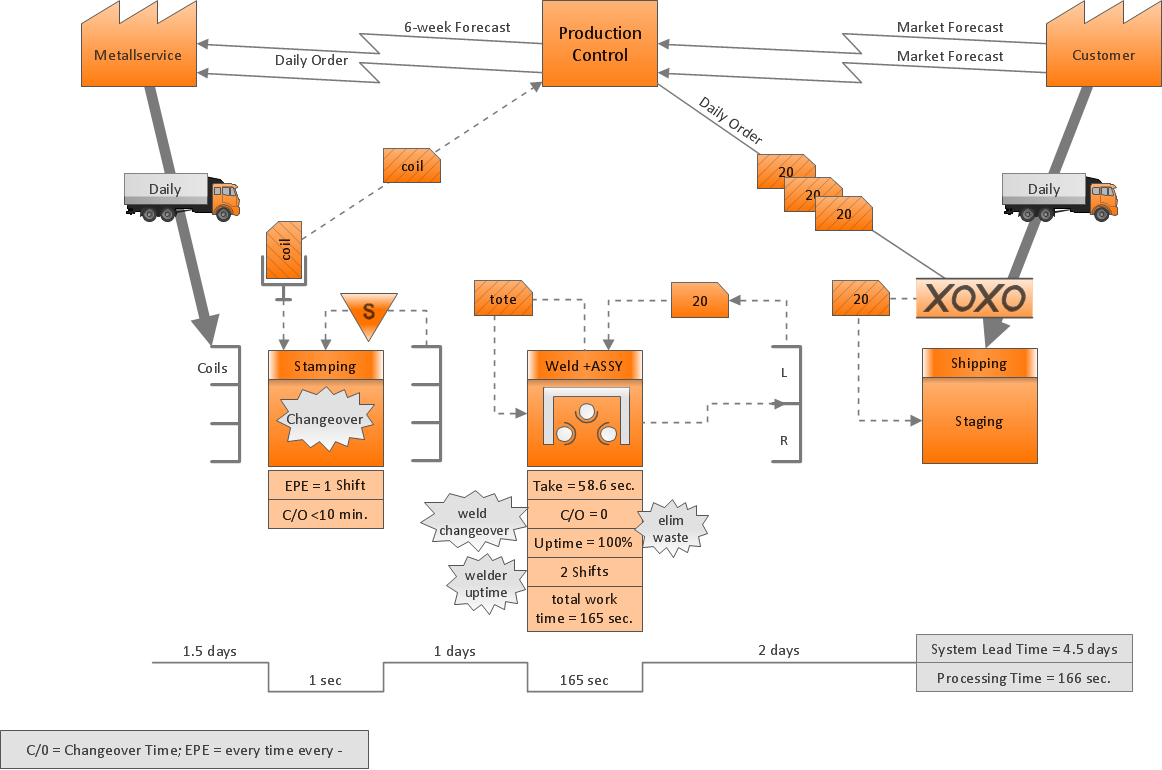Types of Flowcharts
A flowchart is a type of diagram that represents an algorithm, workflow or process, showing the steps as boxes of various kinds, and their order by connecting them with arrows.
Here are brief summaries of the common uses of flowcharts and types of diagrams typically associated with them.

Basic Flowchart
Basic Flowchart is a simple diagram of step-by-step execution of algorithm. It is used at the lowest level of business model description. Basic Flowchart is very simple and visual for creating and understanding. The simple algorithm shapes that represent the processes steps are used for creating the Basic Flowcharts and are connected by arrows that show the order of operations.
Basic Flowcharts are widely used in the different areas of knowledge. But Basic Flowcharts have also some disadvantages: the set of graphic elements is very limited, for example the participants of the business process are not marked on the chart.
- Planning a new project
- Represents an algorithm or process
- Illustrates a solution to a given problem
- Represented process operations
- Used in analyzing
- Used in designing
- Used in documenting
- Used in managing a process
- Used in program in various fields
Example 1. Basic Flowchart
Business Process Modeling Diagram
Business Process Modeling Notation (BPMN) is a standardized graphical notation that allows to create a graphical view of the business processes in a workflow. BPMN standard notation was developed by the Business Process Management Initiative (BPMI) to unify the expression of the business processes, to help all business users easily understand each other using the unified standard. It is a simple and visual tool for businesses and business processes, the common standard for design and implementation of business processes.
In 2011 was standardized the BPMN 2.0. Until then was used the version 1.1.
- Analytical representation of business processes
- Illustrating business processes of an organization
- Bridging the communication gap between business process design and implementation
- Simplifying understanding of business activities flows and processes
- Showing internal business processes to a specific organization
- Depicts the interactions between two or more business entities
- Process improvement
Example 2. Business Process Diagram (BPMN)
Cross Functional Flowchart
Cross Functional Flowchart (also called Deployment Flowchart) is a notation that is used to show the processes on the lower level of the business model. Cross Functional Flowchart displays the detailed algorithm of the business process execution, the participants of the process and the interactions between them.
Cross functional flowcharts use the swim lanes that represent the functional units. They can be arranged horizontal or vertical.
Cross Functional Flowcharts are very simple and useful, but demand a certain degree of detail. They are often used as the tool of the business planning.
- Visualization and communication the operations of a business process flow step-by-step
- Depicts responsible people or departments for each operation
- Simplifying understanding of business activities flows and processes
Example 3. Cross-Functional Flowchart
Data Flow Diagram
Data Flow Diagram (DFD) is one of the main tools for structural analysis and design of the information systems. Data flow diagram graphically represents how the information system work and develop, the interactions between the system and external data sources in terms of data flows, the data flows that the information system receives from the outside.
The DFD Model is a hierarchical model. Each process may be subjected to decomposition, i.e. divided on the structural components, the relationships between them in the same notation can be shown on the separate diagram.
Two notations are used for describing the DFDs: Yourdon & Coad and Gane & Sarson.
- Data management
- Graphical representation of the "flow" of data through an information system
- Modeling process aspects
- An overview of the system
- For the visualization of data processing (structured design)
- What kinds of information will be input to and output from the system
- Where the data will come from and go to
- Where the data will be stored
Example 4. Data Flow Diagram (DFD)
Event-driven Process Chain (EPC) Diagram
Event-Driven Process Chain (EPC) Diagram is a flowchart of business process modeling that uses the Events and Functions as key elements. EPC Diagram must start and end by the event. The function should always follow the event, i.e. the function creates a certain event (state). Documents, organizational units, process owners, information and control flows, elements of the information system have their graphic symbols. The various connectors are provided. For branching of the process are used the logical operators AND, OR, XOR.
The Event-driven Process Chain method was developed within the framework of the ARIS (Architecture of Integrated Information Systems) that is used by the large quantity of companies for business processes modeling, analyzing and redesigning. EPC is used on the lower levels of business model description, when you need to describe the detailed step-by-step execution of the business process, all executors and used objects. Event-Driven Process Chain Diagrams are simple and easy for understanding. They are widely used in the IT field and software development.
But it is needed the special stuff training for creating and understanding of EPC Diagrams. It is a disadvantage of this type of flowcharts.
- Modeling a business process
- Enterprise resource planning
- Business process improvement
- Business process implementation
Example 5. Event-driven Process Chain (EPC) Diagram
IDEF Flowchart
IDEF (Integrated DEFinition) is a methodology of the modeling the complex systems in the field of software engineering. IDEF diagrams were introduced in 1981 as part of the ICAM (Integrated Computer-Aided Manufacturing) project.
The IDEF family includes the IDEF0 - IDEF14 methods, that have the wide range of uses, such as the functional modeling, the object-oriented analysis and design, the knowledge attainments. IDEF0, IDEF1X and IDEF3 are the most used and widely recognized components of the IDEF family.
IDEF0 is functional modeling method that describes the business processes, models the decisions, actions and activities of the complex system or organization. IDEF0 is based on the SADT (Structured Analysis and Design Technique). It is the result of the program of the computerization the industry, which was proposed by the US Air Force. IDEF0 notation was standardized in 1993 by the National Institute of Standards and Technology of the United States Department of Commerce.
- Create function models
- Develop transition schematics
- Design system architecture
- Database design
- Object-oriented design
Example 6. IDEF Flowchart
Influence Diagram (ID)
Influence diagram (ID) is a graphical and mathematical representation of the decision. It is a generalization of the Bayesian network. Influence diagrams are hierarchical. They are the alternative to the decision tree.
Influence diagram represents the directed acyclic graph with three types of nodes (Decision node, Uncertainty node, Value node) and three types of arcs that connect the nodes (Functional arcs, Conditional arcs, Informational arcs).
Influence diagrams are widely used in the decision analysis and in the game theory.
Example 7. Influence Diagram (ID)
Swimlane Flowchart
In each company business-processes are allotted among workers and departments. One the same process may be fulfilled by several workers simultaneously or by turns. In such cases it is quite difficult to define the reasons of delays, defects and narrow places during the process. The documenting of business-processes in the company is required. One of the tools for documenting of business-processes is the Swim Lane diagram.
- Documenting a process
- Mechanism to organize activities into separate visual categories in order
- Illustrate different functional capabilities or responsibilities (organisational roles)
Example 8. Swimlane Flowchart
Process Flow Diagram (PFD)
Process Flow Diagram (PFD) is a flowchart that illustrates the high-level processes in chemical industry and process engineering. PFD displays only the major plant processes not focusing on the insignificant details or components.
Process Flow Diagram can show single or multiple processes. PFD that displays multiple processes is called schematic flow diagram or block flow diagram.
- Oil and petroleum refining
- Natural gas systems
- Green energy, such as wind and solar power
- Water treatment and processes
- Electrical power plants
- Piping and irrigation systems
Example 9. Process Flow Diagram (PFD)
Specification and Description Language (SDL) Diagram
Specification and Description Language (SDL) is a specification language for creating specifications, descriptions of the behavior, data, and inheritance for real-time systems. SDL is used for creating the object-oriented diagrams, visualizing the processes of the state machines for the systems of communication, telecommunication, automotive, aviation and medical industries.
Specification and Description Language provides the graphical Graphic Representation (SDL/GR) and the textual Phrase Representation (SDL/PR).
For creating the SDL diagrams are used the building blocks such as: system definition, block agent, process. Block agents consist of the process agents and communicate using the channels. A process agent is a state machine. A few block agents form the system agent. The message to the agent from another agent or the environment is called a signal and is placed in a queue (the input port).
- Mapping computer algorithms
- Design SDL Diagram
- Develop FSM Diagram
- System Design
- Systems Engineering
- Build real-time system involved in parallel processing
Example 10. Specification and Description Language (SDL) Diagram
Value Stream Mapping
Value stream mapping supports the methods of the lean manufacturing that are used for analyze and design the flow of the materials and information at the system level. This as a result brings the product or service to the consumer. The lead time is a key indicator associated with the value stream mapping.
Value stream mapping are widely used in manufacturing, logistics, product development, software development, healthcare and in other service industries. Value stream mapping is also used as a part of the Six Sigma methodologies.
- Analyze the current process
- Acilitate future state maps
- Make it easier to engage the extended team
- Clearer presentation of the current state
Example 11. Value Stream Map
Workflow Diagram
Workflow Diagram is a graphical description of the information flows, the relationships between the processes of information processing and the objects that are the part of these processes. Workflow Diagram describes the stages of the business or manufacturing processes from the initial to the final stage that allows the organization to trace the progress of the processes quickly and clearly.
For drawing the Workflow Diagrams are used the following shapes: ovals that represent the workflow begins and ends, rectangles that show the process activity, circles that show the connectors from one activity to another and diamonds that signify the process of the decision making.
Workflow Diagrams are important part of the business process management (BPM).
- Managing workflow
- Show pictorial overview of a business, technical or functional process step-by-step
- Model business process to develop, implement, reuse, analyze, solve problems and improve
- Simplify process collaboration by showing workflow in chain of people and business units
- Visualize control and information flow, business process automation, business process re-engineering, accounting, management, and HR tasks
- Document business processes in 6 Sigma or ISO 9000
Example 12. Workflow Diagram

Example 12. Types of Flowcharts
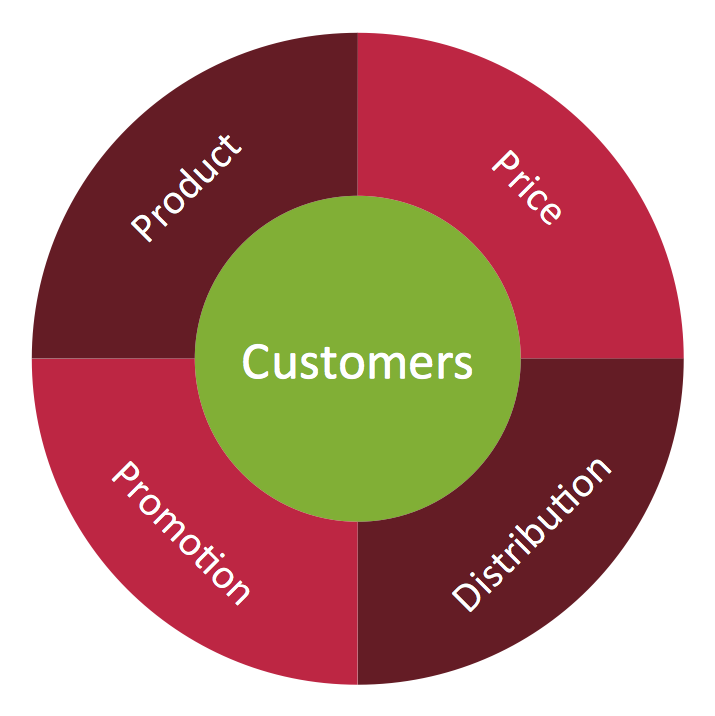


This sample shows the Workflow Diagram that clearly illustrates stages a BPM consists of and relations between all parts of business. The Workflow Diagrams are used to represent the transferring of data during the work process, to study and analysis the working processes, and to optimize a workflow.
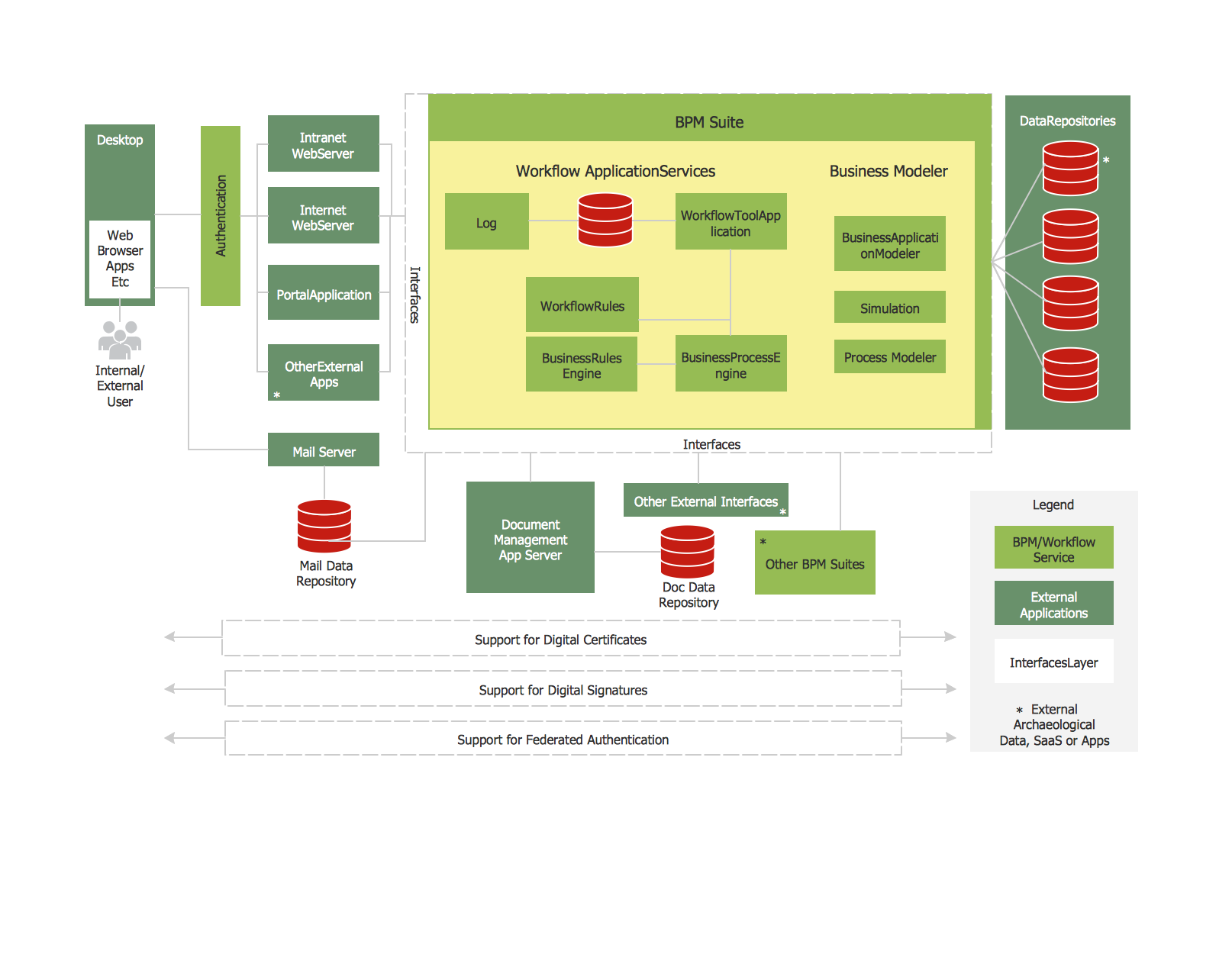

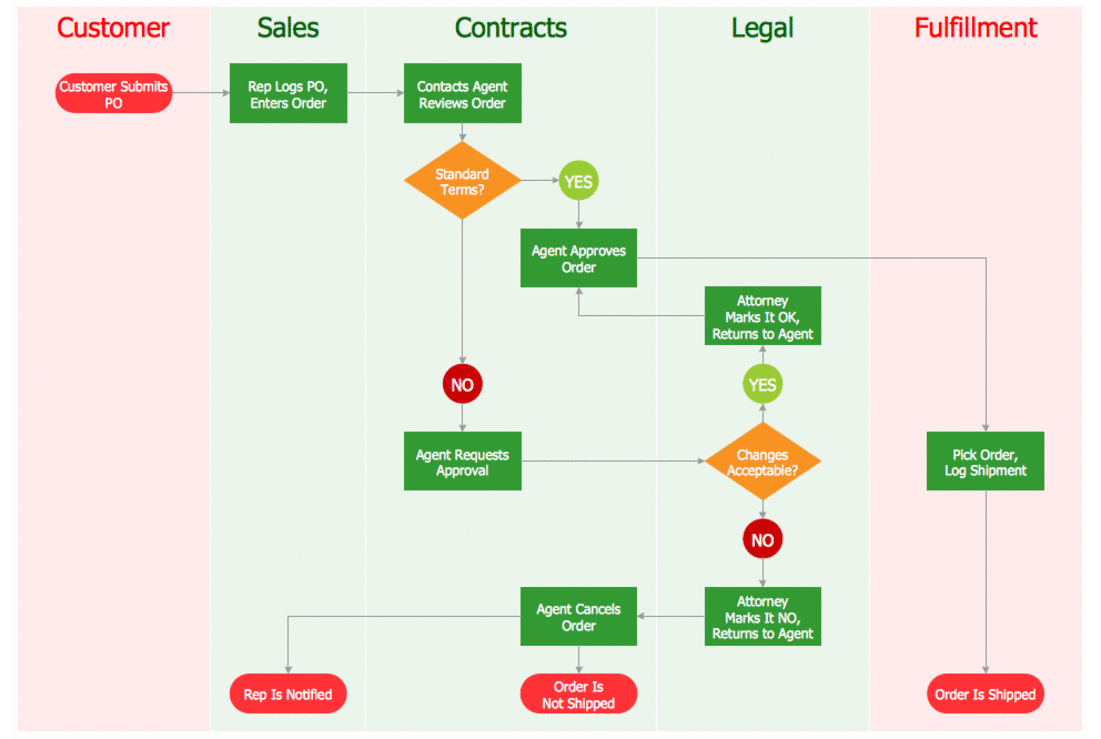
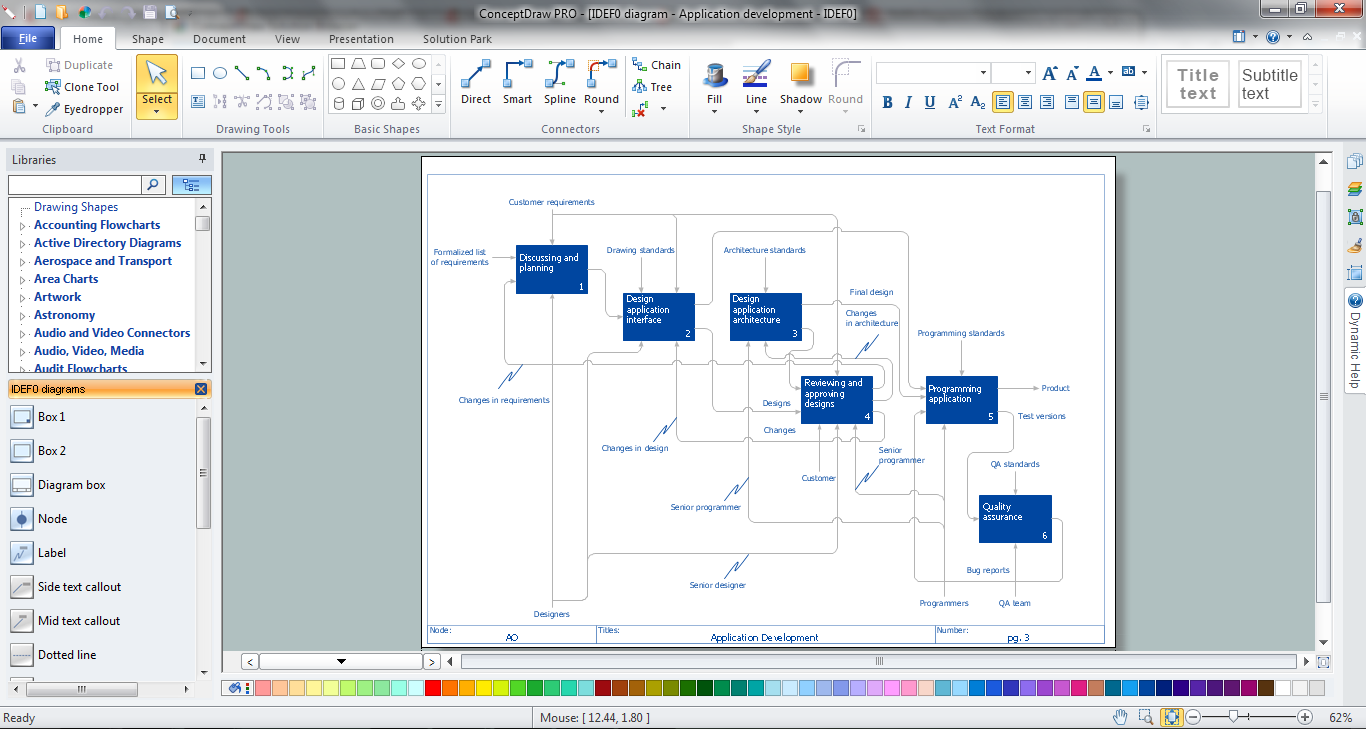

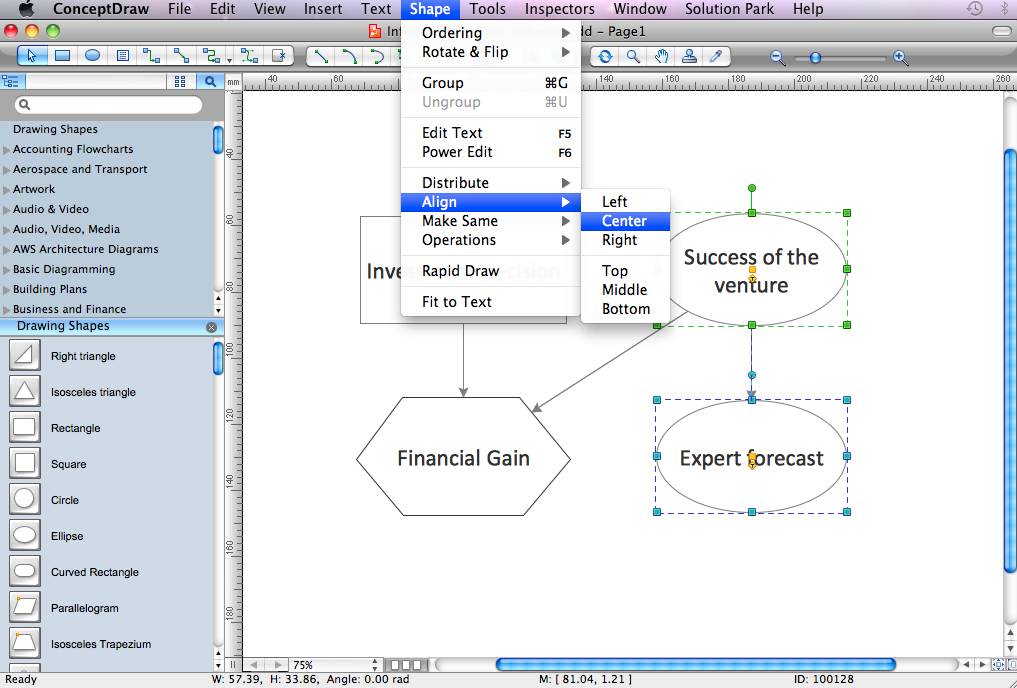


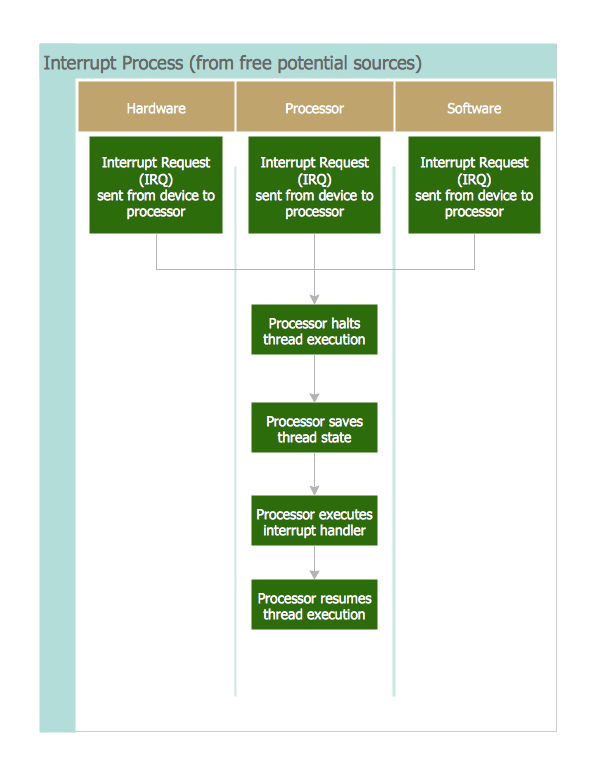


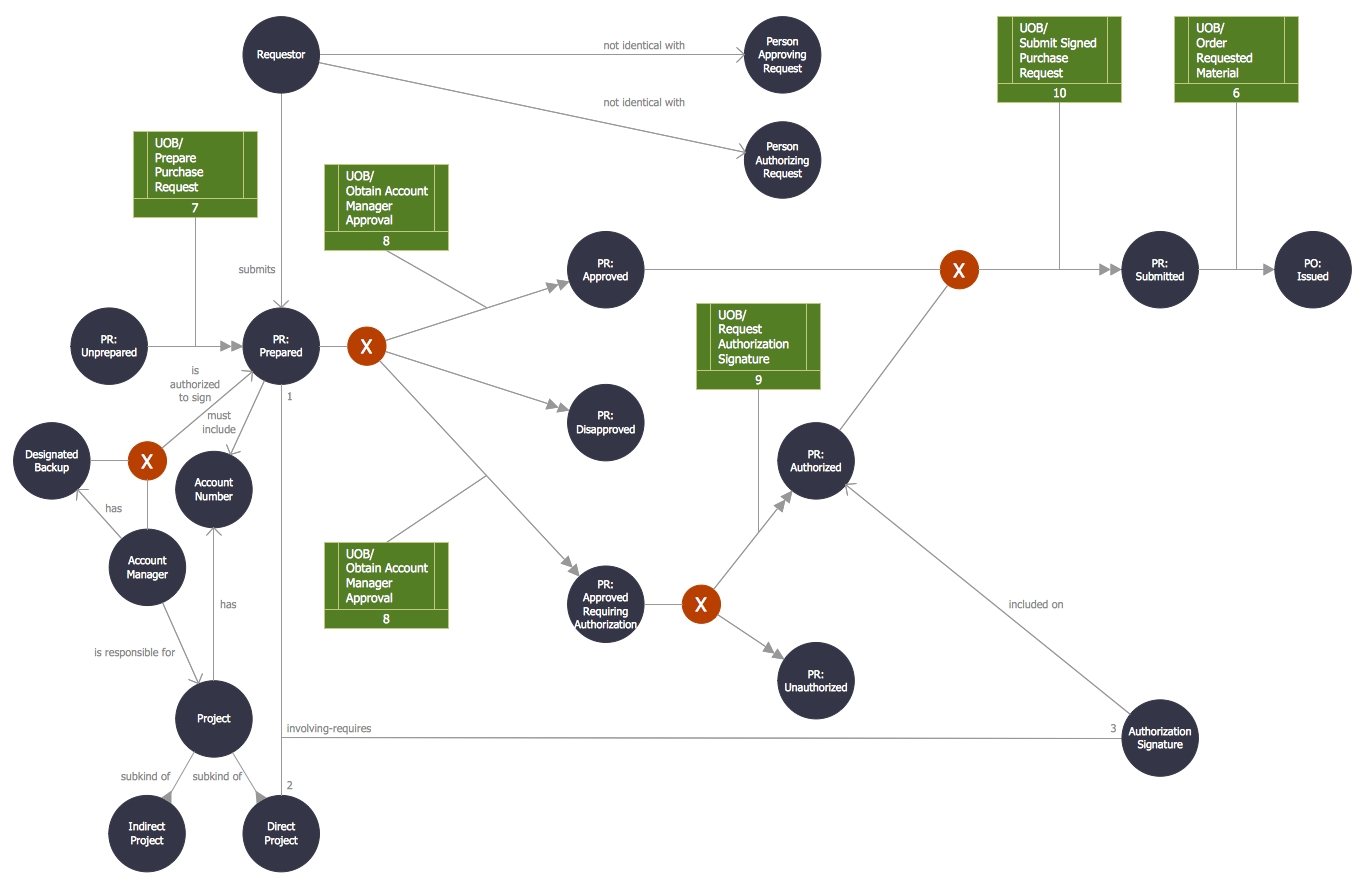
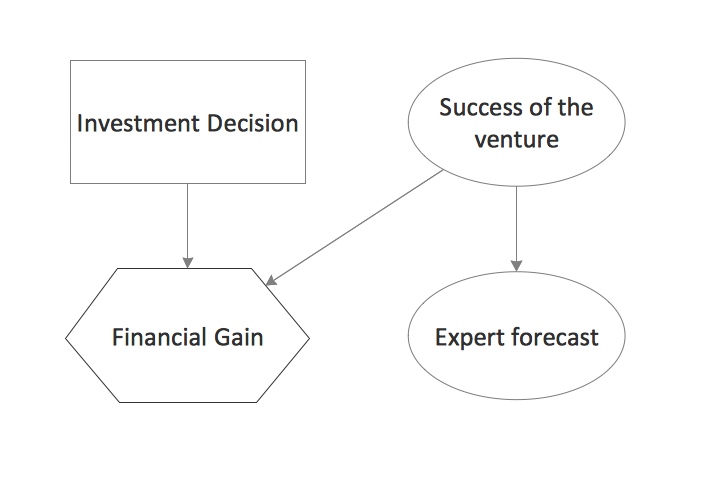

-crude-oil-distillation-unit-pfd.png)

